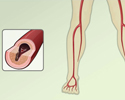Peripheral artery bypass - leg - discharge
Aortobifemoral bypass - discharge; Femoropopliteal - discharge; Femoral popliteal - discharge; Aorta-bifemoral bypass - discharge; Axillo-bifemoral bypass - discharge; Ilio-bifemoral bypass - discharge
When You Were in the Hospital
You had peripheral artery bypass surgery to re-route the blood supply around a blocked artery in one of your legs.
Your surgeon made an incision (cut) over the area where the artery was blocked. This may have been in your leg or groin, or the lower part of your belly. Clamps were placed over the artery at each end of the blocked section. A special tube called a graft was sewn into the artery to replace the blocked part.
You may have stayed in the intensive care unit (ICU) for 1 to 3 days after surgery. After that, you stayed in a regular hospital room.
What to Expect at Home
Your incision may be sore for several days. You should be able to walk farther now without needing to rest. Full recovery from surgery may take 6 to 8 weeks.
Activity
Walk short distances 3 to 4 times a day. Slowly increase how far you walk each time.
When you are resting, keep your leg raised above the level of your heart to prevent leg swelling:
- Lie down and place a pillow under the lower part of your leg.
- DO NOT sit for more than 1 hour at a time when you first come home. If you can, raise your feet and legs when you are sitting. Rest them on another chair or a stool.
You will have more leg swelling after walking or sitting. If you have a lot of swelling, you may be doing too much walking or sitting, or eating too much salt in your diet.
When you climb stairs, use your good leg first when you go up. Use your leg that had surgery first when you go down. Rest after taking several steps.
Your health care provider will tell you when you can drive. You may take short trips as a passenger, but try to sit in the backseat with your leg that had surgery raised up on the seat.
Wound Care
If your staples have been removed, you will probably have Steri-Strips (small pieces of tape) across your incision. Wear loose clothing that does not rub against your incision.
You may shower or get the incision wet, once your doctor says you can. DO NOT soak, scrub, or have the shower beat directly on them. If you have Steri-Strips, they will curl up and fall off on their own after a week.
DO NOT soak in the bath tub, a hot tub, or swimming pool. Ask your provider when you can start doing these activities again.
Your provider will tell you how often to change your dressing (bandage) and when you may stop using one. Keep your wound dry. If your incision goes to your groin, keep a dry gauze pad over it to keep it dry.
- Clean your incision with soap and water every day once your provider says you can. Look carefully for any changes. Gently pat it dry.
- DO NOT put any lotion, cream, or herbal remedy on your wound without asking first if that is ok.
Self-care
Bypass surgery does not cure the cause of the blockage in your arteries. Your arteries may become narrow again.
- Eat a heart-healthy diet, exercise, stop smoking (if you smoke), and reduce your stress. Doing these things will help lower your chances of having a blocked artery again.
-
Your health care provider may give you
medicine to help lower your cholesterol
.
Medicine to help lower your cholesterol
Hyperlipidemia - drug treatment; Hardening of the arteries - statin
Read Article Now Book Mark Article - If you are taking medicines for high blood pressure or diabetes, take them as you have been told to take them.
-
Your provider may
ask you to take aspirin
or a
medicine called clopidogrel (Plavix)
when you go home. These medicines keep your blood from forming clots in your arteries. DO NOT stop taking them without talking with your provider first.
Ask you to take aspirin
Blood thinners - aspirin; Antiplatelet therapy - aspirin
Read Article Now Book Mark ArticleMedicine called clopidogrel (Plavix)
Blood thinners - clopidogrel; Antiplatelet therapy - clopidogrel; Thienopyridines
Read Article Now Book Mark Article
When to Call the Doctor
Call your health care provider if:
- Your leg that had surgery changes color or becomes cool to touch, pale, or numb
- You have chest pain, dizziness, problems thinking clearly, or shortness of breath that does not go away when you rest
- You are coughing up blood or yellow or green mucus
- You have chills
- You have a fever over 101°F (38.3°C)
- Your belly hurts or is bloated
- The edges of your surgical incision are pulling apart
- There are signs of infection around the incision such as redness, pain, warmth, welling, or greenish discharge
- The bandage is soaked with blood
- Your legs are swelling
References
Creager MA and Libby P. Peripheral arterial diseases. In: Mann DL, Zipes DP, Libby P, Bonow RO, Braunwald E, eds. Braunwald's Heart Disease: A Textbook of Cardiovascular Medicine . 10th ed. Philadelphia, PA: Elsevier Saunders; 2015:chap 58.
Kinlay S, Bhatt DL. Treatment of noncoronary obstructive vascular disease. In: Mann DL, Zipes DP, Libby P, Bonow RO, Braunwald E, eds. Braunwald's Heart Disease: A Textbook of Cardiovascular Medicine . 10th ed. Philadelphia, PA: Elsevier Saunders; 2015:chap 60.
Review Date: 1/9/2015
Reviewed By: Michael A. Chen, MD, PhD, Associate Professor of Medicine, Division of Cardiology, Harborview Medical Center, University of Washington Medical School, Seattle, WA. Also reviewed by David Zieve, MD, MHA, Isla Ogilvie, PhD, and the A.D.A.M. Editorial team.

